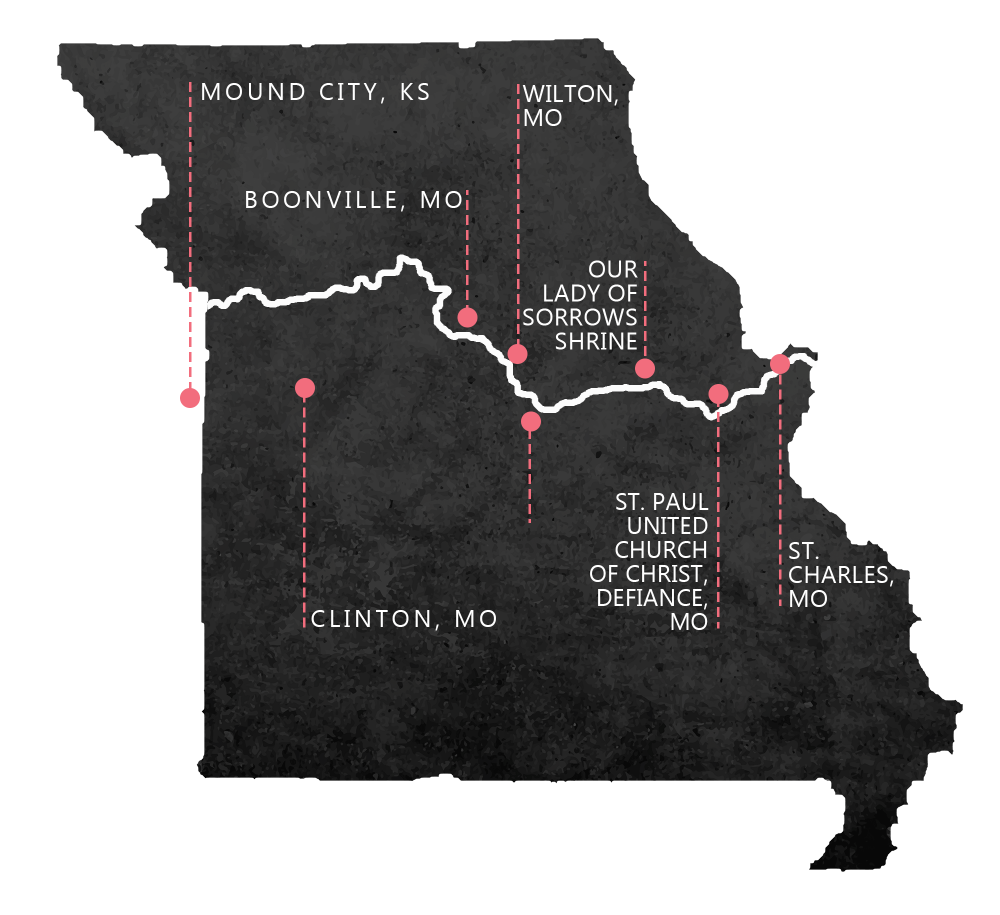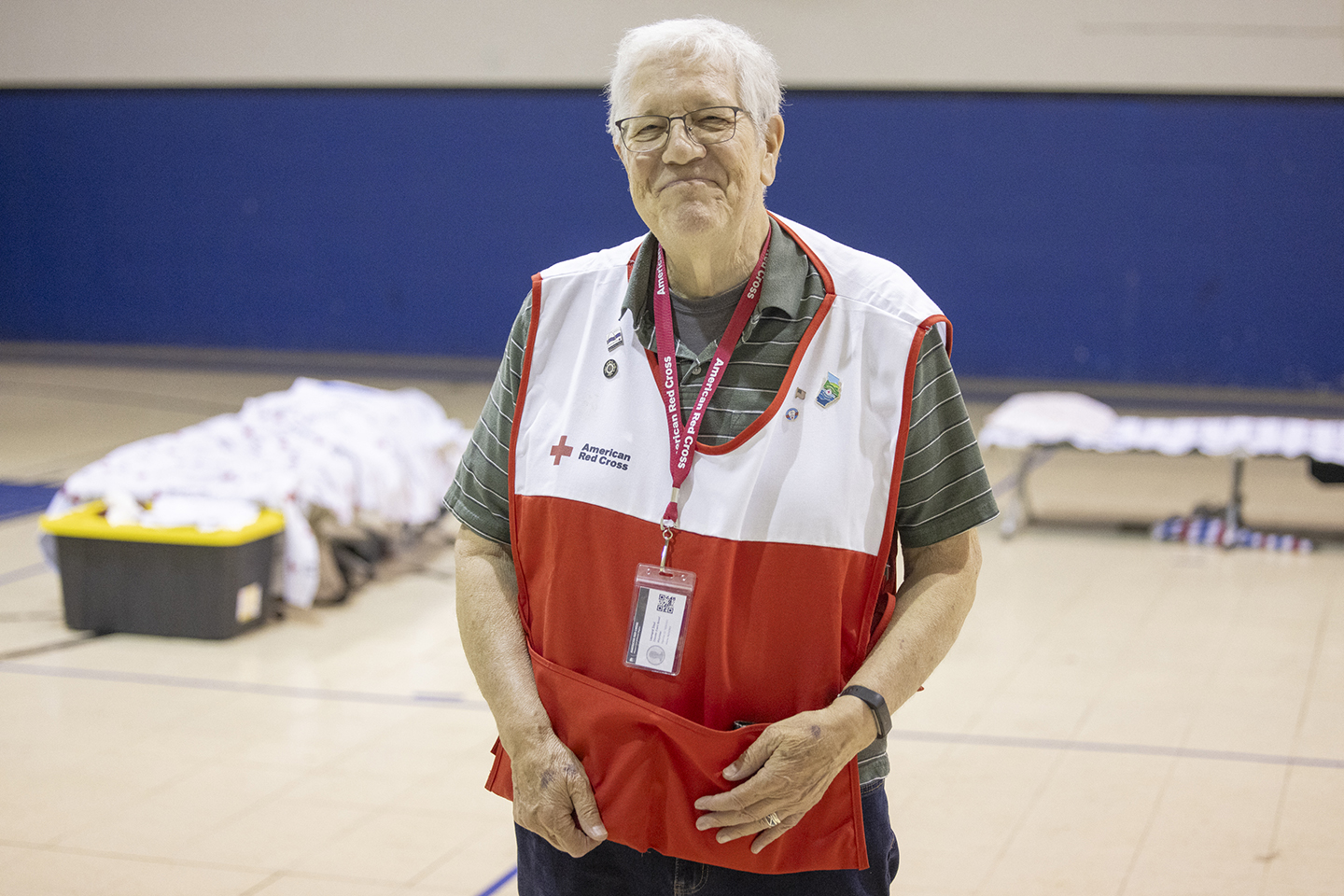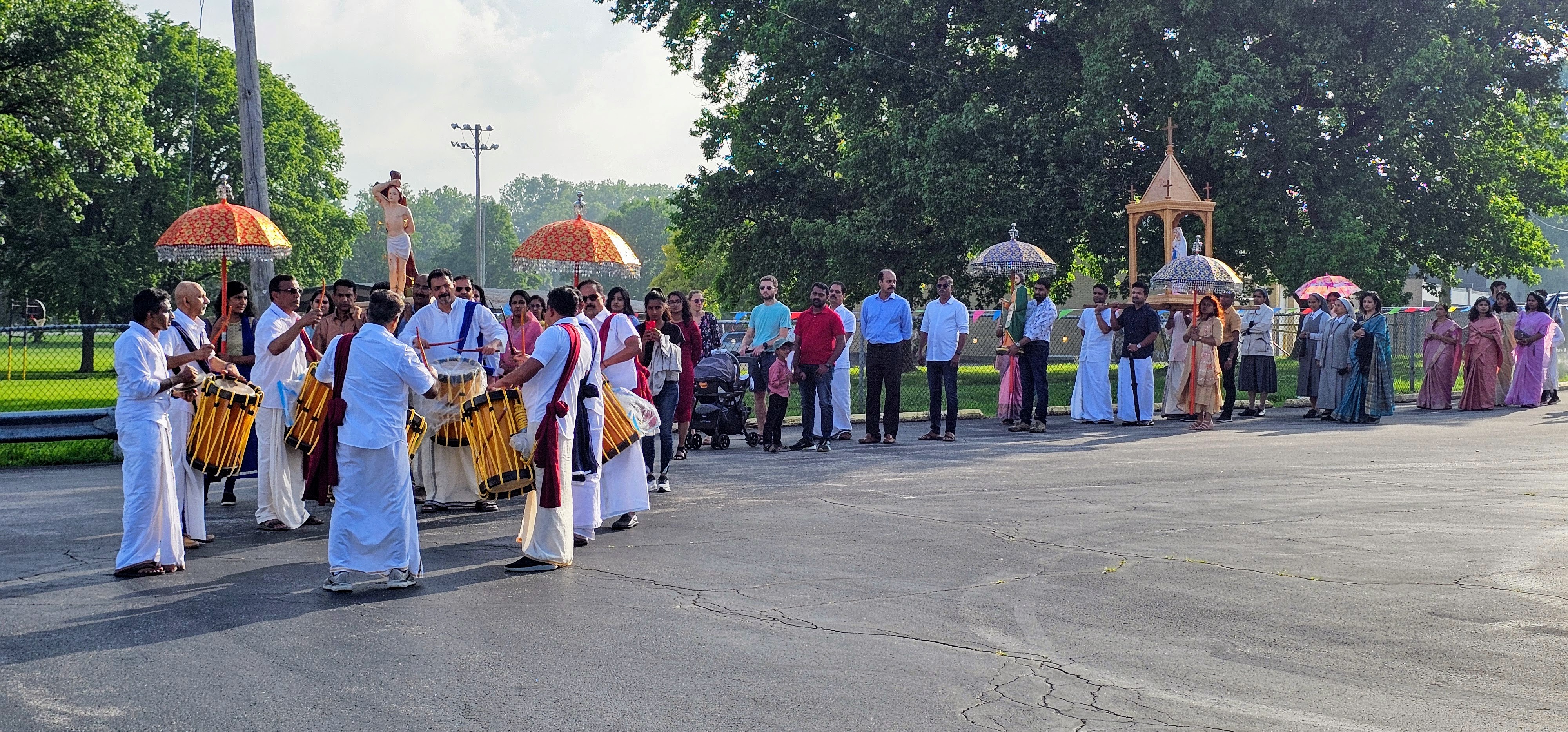Three pilgrims journey to explore where St. Rose Philippine Duchesne ministered

Ann Sieben looks exactly like what you’d expect of a pilgrim.
Tanned skin and rosy cheeks are evidence of spending hours under the sun. If her boots could talk, they’d explain that the light coat of dust is from walking on a trail for weeks. Sieben’s bright, big smile, though, is a tell-all of the energy and vibrancy it takes for a journey by foot to visit the places where an American saint once lived and worked.
Sieben and her friends, Roscoe Hill and Jim Adams, walked 335 miles in 25 days to experience the spirit of the journey of St. Rose Philippine Duchesne, who arrived in America in 1818 to establish schools here with her community, the Society of the Sacred Heart.
The pilgrims started their journey in Mound City, Kan., near where St. Rose Philippine prayed with the Potawatomi Native Americans. They walked from Kansas into Missouri, eventually connecting with the western terminus of the Katy Trail in Clinton, Mo. Following the trail all the way to St. Charles, the pilgrimage ended May 18 at the Academy of the Sacred Heart, where the saint taught and her final resting place.
Sieben, 53, who has made this her vocation as a consecrated layperson with the Society of Servant Pilgrims, had only heard of St. Rose Philippine a year ago. “I’m from New Jersey,” she said with a grin. But nevertheless, she recognized the historic importance of the anniversary of the saint’s arrival and how she pioneered educating children in rough, frontier conditions.
“Part of the pilgrimage experience was really to connect with her experience,” Sieben said. “The pilgrimage puts us in touch with the earth and the elements and what she was facing. We give up the comforts of home, and she had no comforts.”
Saints and pilgrims go hand in hand, because of the journey that both experience, she explained. “The saints are saints because they exercised heroic virtue in their lifetime,” Sieben said. “They left examples for all of us of how they lived their day-to-day holy life. This is why saints and pilgrims go together. We (get to visit) a destination where the saint did their work, where they walked, and did these heroic, virtuous things.”
Mapping a plan
Sieben placed two small booklets on a table. One was a long piece of card stock folded in sixths. It was filled with signatures and stamps of the places they stopped along the route. The other was a small booklet, inserted with three pieces of paper that unfolded, revealing list of anticipated places where they could stop.
These were the group’s lifelines. The card stock acted as a passport, filled with the signatures of people they stayed with or visited along the way. They could show it to those in the next town when vying for a place to stay. It’s something that pilgrims have used for more than 1,000 years and was the precursor to the national passport, Sieben explained.
“It’s a pilgrim’s credential,” she explained. “I can say, ‘look, we’re certified by the archbishop of Denver, and we’re signed by the Archbishop of Kansas City,’ They see the signatures and say, ‘Oh I know Mary Wally, oh yes, of course, you can stay here.'”
With Google Maps, Sieben sketched a route starting from Mound City, and heading east to Clinton, Mo., where they picked up on the Katy Trail. In that first stretch of 81 miles, “I just had to figure out where to go on the dirt roads, farm roads, and find churches and walk from church to church,” she said.
Sieben has had more than a decade of experience with this. As a mendicant pilgrim (one who dedicates her life to walking on pilgrimages, often going solo and carrying nothing of value) she started the Society of Servant Pilgrims under the approval of the Archdiocese of Denver. In 2016, the society became an official Association of the Christian Faithful under canon law.
The route didn’t precisely follow St. Rose Philippine’s steps, but the group stayed as authentically connected as possible by paralleling the Missouri River, and witnessing native prairie land as the saint would have seen it. They averaged about 13 miles a day. Sieben walked faster than the other two, so she would arrive at a town for the evening and look for someone to make arrangements to stay at a church for the night.
Finding refuge in small towns was fairly easy, but grew more difficult as they got closer to the St. Louis area. In St. Charles County, the first church Sieben tried was closed. They moved along to a Christian mega church and were told they couldn’t stay the night because of a policy that required a staff person to be on site. The church, however, welcomed Sieben in to use the computer and charge her phone.
The pilgrims seemed to make the biggest impact in the smallest towns. Calhoun Baptist Church in Calhoun, Mo., (near Clinton) was especially welcoming, they said. On the fifth Sunday of the month, the church joins with several other Christian churches in the area for an ecumenical “Singspiration,” and sing church hymns and share testimony. The three were welcomed with open arms to join them in their fellowship.
“The Protestants know nothing about pilgrimage, but they know about being welcoming,” Sieben said. “They were so moved by what we were doing” as they shared their knowledge of St. Rose Philippine Duchesne.
At several churches, the group found an image of Jesus knocking on a door — a sign of welcome to pilgrims. “When someone knocks on the door, you should treat them as Jesus,” Sieben said. “I think, ‘How many doors were opened to us with this spirit?'”
The making of a team
Three years ago, Sieben met Jim Adams at a national pilgrims’ gathering at the Shrine of Our Lady of the Snows in Belleville, Ill. Adams, 75, who attends Our Lady of Lourdes Parish in University City, had been interested in El Camino de Santiago in Spain, but never got to walk along the famed pilgrimage route.
Last year at the same gathering in Belleville, Adams told her about St. Rose Philippine Duchesne. He had been reading about the American saint — one of 10 American saints to be exact — and the bicentennial celebration in 2018. Sieben gave a talk on how part of her vocation is to help other pilgrims. “It occurred to me that Ann probably would be able to do something with this,” he said.
Roscoe Hill, 80, met Sieben in Denver. About 10 years ago, he and his wife, Sheila, walked El Camino de Santiago with friends. One of those friends was walking about seven or eight years ago in the Denver area and saw a woman who had a scalloped shell tattoo on her left shoulder — a symbol of a pilgrim. It was Sieben. Hill and his wife were introduced to her through the friends, and they kept in touch.
When Sieben returned in 2016 from a pilgrimage that extended from Denver to Quebec, Canada, Hill ran into her once again and learned of her plans to go to Kansas and Missouri. “I sort of asked her one day, ‘I’m not making any commitments, but if I wished, could I come along?'”
Turns out there was some divine coincidence involved.
The day they reached St. Charles, May 18, marked the 18-month anniversary since his wife had passed away.
As Hill held back the tears, Sieben finished explaining.
“It was exactly today 18 months ago, on Nov. 18, which is St. Rose Philippine Duchesne’s feast day,” she said. “And St. Rose was the feisty educator — can we agree? — Roscoe’s wife was also a feisty educator.”
Adams felt the benefits of doing a cross-state walking pilgrimage. “Ninety percent of what we have to do with our brain is put out the other stuff,” he said. “When you’re walking by yourself like this and there’s no industrial sound, no mad rat race going on all around you, it just opens you up. You don’t have to spend all your energy taking all the distractions away. When you get used to the blisters and other inconveniences, you get in a rhythm and it’s very restful. It made me appreciate walking. I might do this again.”
Society of the Sacred Heart bicentennial celebrations
June 23, 2017: St. Rose Philippine receives a star on the St. Louis Walk of Fame, University City
June 23, 2017: Celebration of the feast of the Sacred Heart, online from the chapel at Villa Duchesne High School, St. Louis
July 12-16, 2017: Spirituality forum at St. Louis University
July 17-18, 2017: Pilgrimage from St. Charles to Sugar Creek, Kan.
Nov. 18, 2017: Online year of prayer begins
July 19, 2018: Unveiling of St. Rose Philippine sculpture at the Cathedral Basilica of St. Louis
July 19, 2018: Presentation by Cokie Roberts (famed Sacred Heart alumna) at the Missouri History Museum
July 19-22, 2018: Frontiers Conference at the Pallottine Renewal Center, Florissant
Sept. 7, 2018: Re-enactment on the St. Charles riverfront
Sept. 14, 2018: Mass at the Academy of the Sacred Heart, St. Charles, with Archbishop Robert J. Carlson
Sept. 15, 2018: Global Service Day; begins with sunrise prayer service at Baradene College of the Sacred Heart, New Zealand
Nov. 18, 2018: Eucharistic celebrations around the world, including in St. Louis at the Cathedral Basilica of St. Louis with Archbishop Carlson
To learn more deatils about the upcoming events, visit rscj.org/bicentennial2018.
>> Make a pilgrimage
Ann Sieben is planning two more walking pilgrimages, tentatively scheduled April 30-May 24, 2018; and again Oct. 24-Nov. 18, 2018. Sieben also will have information on how to make a similar pilgrimage on your own. Information will be posted at rscj.org/bicentennial2018. To learn more, email editor@rscj.org.
The Society of the Sacred Heart website also has a list of sites to visit where St. Rose Philippine Duchesne lived and ministered. To learn more, visit www.rscj.org/bicentennial2018/places-visit
To learn more about the Society of Servant Pilgrims, see www.societyofservantpilgrims.com.
RELATED ARTICLE(S): (Unpublished) Celebrating St. Rose Philippine Duchesne with 24 hours of prayer
Ann Sieben looks exactly like what you’d expect of a pilgrim. Tanned skin and rosy cheeks are evidence of spending hours under the sun. If her boots could talk, they’d … Three pilgrims journey to explore where St. Rose Philippine Duchesne ministered
Subscribe to Read All St. Louis Review Stories
All readers receive 5 stories to read free per month. After that, readers will need to be logged in.
If you are currently receive the St. Louis Review at your home or office, please send your name and address (and subscriber id if you know it) to subscriptions@stlouisreview.com to get your login information.
If you are not currently a subscriber to the St. Louis Review, please contact subscriptions@stlouisreview.com for information on how to subscribe.







